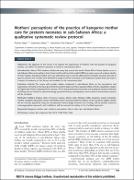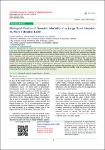| dc.contributor.author | Katugume, Brendah | |
| dc.contributor.author | Muzungu, JohnBaptist | |
| dc.contributor.author | Okello, Nelson | |
| dc.contributor.author | Kigongo, Eustes | |
| dc.contributor.author | Namutebi, Deborah Andrinar | |
| dc.date.accessioned | 2023-10-25T14:00:58Z | |
| dc.date.available | 2023-10-25T14:00:58Z | |
| dc.date.issued | 2023 | |
| dc.identifier.citation | Katugume, B., Muzungu, J., Okello, N., Kigongo, E., & Namutebi, D. A. (2023). Prevalence of neonatal sepsis and associated factors among neonates admitted in the neonatal intensive care unit at Lira regional referral hospital, northern Uganda [Preprint]. In Review. https://doi.org/10.21203/rs.3.rs-3309937/v1 | en_US |
| dc.identifier.issn | https://doi.org/10.21203/rs.3.rs-3309937/v1 | |
| dc.identifier.uri | http://ir.lirauni.ac.ug/xmlui/handle/123456789/763 | |
| dc.description.abstract | BACKGROUND: Sepsis is one of the leading causes of mortality and morbidity among neonates. Neonatal
sepsis (NS) contributes to 44% of 5.4 million under-5 mortalities globally, and 12% of neonatal deaths in
Uganda in 2020 were attributed to NS. Early risk factor identification and improved obstetric care are proven to
reduce deaths due to NS, yet there is scanty literature for the Lango sub-region. We, therefore, determined the
prevalence of NS, and identified the factors associated with NS in the Lango sub-region of northern Uganda.
METHODS: A hospital-based, quantitative, cross-sectional study with a retrospective chart review was
conducted in the neonatal intensive care unit (NICU) at Lira regional referral hospital (LRRH), in northern
Uganda, among 194 records of neonates admitted to the NICU from September 2022 to February 2023. The
participant records were selected by systematic sampling technique and a structured data extraction tool was
used to collect data. Using SPSS version 25 data entry and analysis were done. The univariate analysis gave a
general description of the data. Using logistic regression analysis associations were measured and the
statistical significance was declared at a P value of 0.05 after multivariate analysis.
RESULTS: Among a total of 194 neonates whose charts were reviewed, 80% of these had neonatal sepsis,
giving a prevalence of 41.2%. Age in days of the neonate (AOR=4.212[1.627-10.903]) for neonates of 1-3days of
age, sex where males (AOR=2.09[1.123-3.887]), an APGAR score of 1-4 at birth (AOR= 0.309, 95% CI: [0.115-
0.831]) and weight at birth <2500g (AOR=2.543[1.381-4.683]) were significantly related to NS.
CONCLUSIONS AND RECOMMENDATIONS: The prevalence of NS among neonates admitted to the NICU of
LRRH was high at 41.2% and the neonates of 1-3 days of age, male sex, a birth weight of <2500g, and an Apgar
score of 1-4 at birth were significantly related to NS. Therefore, Caregivers ensure safe newborn care, early
infection detection, and prophylactic antibiotics during procedures, especially for neonates with low birth
weight, and low Apgar score males during the first 3 days of life are recommended to reduce the risk of
developing NS. Further research is to be conducted on the major causative agents and outcomes of NS. | en_US |
| dc.language.iso | en | en_US |
| dc.publisher | Research Square | en_US |
| dc.subject | neonatal sepsis | en_US |
| dc.subject | neonatal intensive care | en_US |
| dc.title | Prevalence of neonatal sepsis and associated factors among neonates admitted in the neonatal intensive care unit at Lira regional referral hospital, northern Uganda | en_US |
| dc.type | Article | en_US |




